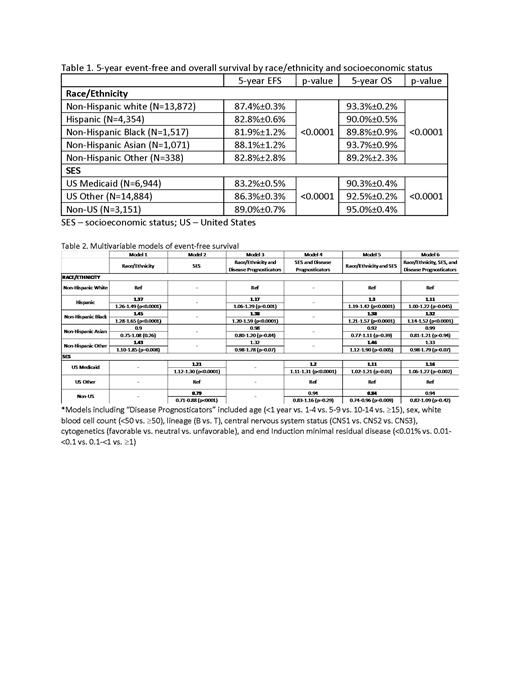Abstract

Introduction: Health disparities are major issue for racial, ethnic, and socioeconomically disadvantaged groups. Though outcomes in childhood acute lymphoblastic leukemia (ALL) have steadily improved, identifying persistent disparities is critical. Prior studies evaluating ALL outcomes by race or ethnicity have noted narrowing disparities or that residual disparities are secondary to differences in leukemia biology or socioeconomic status (SES). We aimed to identify persistent inequities by race/ethnicity and SES in childhood ALL in the largest cohort ever assembled for this purpose.
Methods: We identified a cohort of newly-diagnosed patients with ALL, age 0-30.99 years who were enrolled on COG trials between 2004-2019. Race/ethnicity was categorized as non-Hispanic white vs. Hispanic vs. non-Hispanic Black vs. non-Hispanic Asian vs. Non-Hispanic other. SES was proxied by insurance status: United States (US) Medicaid (public health insurance for low-income individuals) vs. US other (predominantly private insurance) vs. non-US patients (mainly jurisdictions with universal health insurance). Event-free and overall survival (EFS, OS) were compared across race/ethnicity and SES. The relative contribution of disease prognosticators (age, sex, white blood cell count, lineage, central nervous system status, cytogenetics, end Induction minimal residual disease) was examined with Cox proportional hazard multivariable models of different combinations of the three constructs of interest (race/ethnicity, SES, disease prognosticators) and examining hazard ratio (HR) attenuation between models.
Results: The study cohort included 24,979 children, adolescents, and young adults with ALL. Non-Hispanic White patients were 13,872 (65.6%) of the cohort, followed by 4,354 (20.6%) Hispanic patients and 1,517 (7.2%) non-Hispanic Black patients. Those insured with US Medicaid were 6,944 (27.8%). Five-year EFS (Table 1) was 87.4%±0.3% among non-Hispanic White patients vs. 82.8%±0.6% [HR 1.37, 95 th confidence interval (95CI) 1.26-1.49; p<0.0001] among Hispanic patients and 81.9%±1.2% (HR 1.45, 95CI 1.28-1.56; p<0.0001) among non-Hispanic Black patients. Outcomes for non-Hispanic Asian patients were similar to those of non-Hispanic White patients. US patients on Medicaid had inferior 5-year EFS as compared to other US patients (83.2%±0.5% vs. 86.3%±0.3%, HR 1.21, 95CI 1.12-1.30; p<0.0001) while non-US patients had the best outcomes (5-year EFS 89.0%±0.7%, HR 0.78, 95CI 0.71-0.88; p<0.0001). There was substantial imbalance in traditional disease prognosticators (e.g. T-cell lineage) across both race/ethnicity and SES, and of race/ethnicity by SES. For example, T-lineage ALL accounted for 17.6%, 9.4%, and 6.6% of Non-Hispanic Black, Non-Hispanic White, and Hispanic patients respectively (p<0.0001).
Table 2 shows the multivariable models and illustrates different patterns of HR adjustment among specific racial/ethnic and SES groups. Inferior EFS among Hispanic patients was substantially attenuated by the addition of disease prognosticators (HR decreased from 1.37 to 1.17) and further (but not fully) attenuated by the subsequent addition of SES (HR 1.11). In contrast, the increased risk among non-Hispanic Black children was minimally attenuated by both the addition of disease prognosticators and subsequent addition of SES (HR 1.45 to 1.38 to 1.32). Similarly, while the superior EFS of non-US insured patients was substantially attenuated by the addition of race/ethnicity and disease prognosticators (HR 0.79 to 0.94), increased risk among US Medicaid patients was minimally attenuated by the addition of race/ethnicity or disease prognosticators (HR 1.21 to 1.16). OS disparities followed similar patterns but were consistently worse than in EFS, particularly among patients grouped as non-Hispanic other.
Conclusions: Substantial disparities in survival outcomes persist by race/ethnicity and SES in the modern era. Our findings suggest that reasons for these disparities vary between specific disadvantaged groups. Additional work is required to identify specific drivers of survival disparities that may be mitigated by targeted interventions.
Gupta: Jazz Pharmaceuticals: Consultancy, Membership on an entity's Board of Directors or advisory committees. Teachey: NeoImmune Tech: Research Funding; Sobi: Consultancy; BEAM Therapeutics: Consultancy, Research Funding; Janssen: Consultancy. Zweidler-McKay: ImmunoGen: Current Employment. Loh: MediSix therapeutics: Membership on an entity's Board of Directors or advisory committees.
Author notes
 This icon denotes a clinically relevant abstract
This icon denotes a clinically relevant abstract


This feature is available to Subscribers Only
Sign In or Create an Account Close Modal